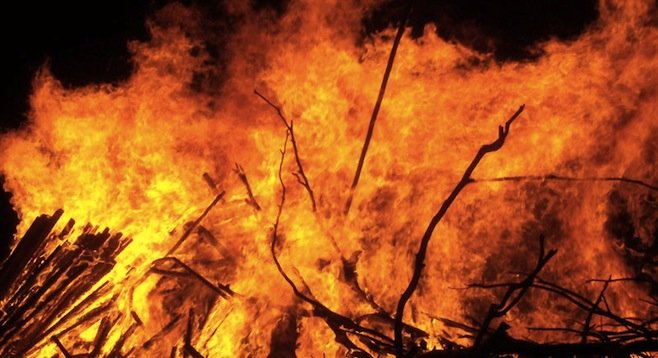 Facebook
Facebook
 X
X
 Instagram
Instagram
 TikTok
TikTok
 Youtube
Youtube

Members of the Al Bahr Mount Laguna Shrine Camp are asking the federal government to take responsibility for the loss of their 90-year-old lodge and 116 cabins destroyed in the Chariot Fire in 2013.
Shriners have lived on the 25-acre camp, located near Sunrise Highway in eastern San Diego County, since 1921, the year they entered into a lease with the U.S. Forest Service.
For nearly a century, the camp withstood numerous threats by wildfires; that changed in July 2013, when over 7000 acres burned as a result of sparks from a Bureau of Land Management vehicle.
In June of this year, the Shriners lodged a formal complaint against the government for $20 million. Their complaint was denied. Now, the group is seeking compensation in order to build anew.
On August 22, the Shriners filed a lawsuit in federal court. In it, they accuse Bureau of Land Management employee Jason Peters of "knowingly, recklessly, or intentionally" igniting the fire by failing to remove debris from under his government issued Jeep on and off road.
"Said debris, brush, and other materials in the undercarriage of the Jeep ignited from contact with certain component parts of the Jeep including but not limited to the catalytic converter or other parts of the exhaust system, and/or the engine block, fuel delivery system, and/or other parts of the Jeep. The ignited fire spread and ignited other material including plastic material of the Jeep, including the plastic fuel line to the engine compartment creating a fire underneath the Jeep as Jason Peters negligently, recklessly, and intentionally drove his Jeep across and around the desert floor on and off road while under the course and scope of employment with the [Bureau of Land Management]. Fire activity was accelerated as the fuel tank contents drained out of the burned fuel line.
"Defendants knew or should have known that the Jeep posed the threat of and created the dangerous condition in and around an area that was extremely susceptible to wild fire based on factors including but not limited to: a) Temperatures in the fire area were 6-7 degrees Fahrenheit above average; b) the Burn Index, based on ten years of climatology, was near or at record maximum levels, supporting an exceptionally high probability for large fire growth; c) live fuel moistures were averaging 60%, a critical level; d) winds of five miles per hour with gusts up to 21 miles per hour; and e) the probability of ignition was calculated to be at 90 percent."


Members of the Al Bahr Mount Laguna Shrine Camp are asking the federal government to take responsibility for the loss of their 90-year-old lodge and 116 cabins destroyed in the Chariot Fire in 2013.
Shriners have lived on the 25-acre camp, located near Sunrise Highway in eastern San Diego County, since 1921, the year they entered into a lease with the U.S. Forest Service.
For nearly a century, the camp withstood numerous threats by wildfires; that changed in July 2013, when over 7000 acres burned as a result of sparks from a Bureau of Land Management vehicle.
In June of this year, the Shriners lodged a formal complaint against the government for $20 million. Their complaint was denied. Now, the group is seeking compensation in order to build anew.
On August 22, the Shriners filed a lawsuit in federal court. In it, they accuse Bureau of Land Management employee Jason Peters of "knowingly, recklessly, or intentionally" igniting the fire by failing to remove debris from under his government issued Jeep on and off road.
"Said debris, brush, and other materials in the undercarriage of the Jeep ignited from contact with certain component parts of the Jeep including but not limited to the catalytic converter or other parts of the exhaust system, and/or the engine block, fuel delivery system, and/or other parts of the Jeep. The ignited fire spread and ignited other material including plastic material of the Jeep, including the plastic fuel line to the engine compartment creating a fire underneath the Jeep as Jason Peters negligently, recklessly, and intentionally drove his Jeep across and around the desert floor on and off road while under the course and scope of employment with the [Bureau of Land Management]. Fire activity was accelerated as the fuel tank contents drained out of the burned fuel line.
"Defendants knew or should have known that the Jeep posed the threat of and created the dangerous condition in and around an area that was extremely susceptible to wild fire based on factors including but not limited to: a) Temperatures in the fire area were 6-7 degrees Fahrenheit above average; b) the Burn Index, based on ten years of climatology, was near or at record maximum levels, supporting an exceptionally high probability for large fire growth; c) live fuel moistures were averaging 60%, a critical level; d) winds of five miles per hour with gusts up to 21 miles per hour; and e) the probability of ignition was calculated to be at 90 percent."
Comments